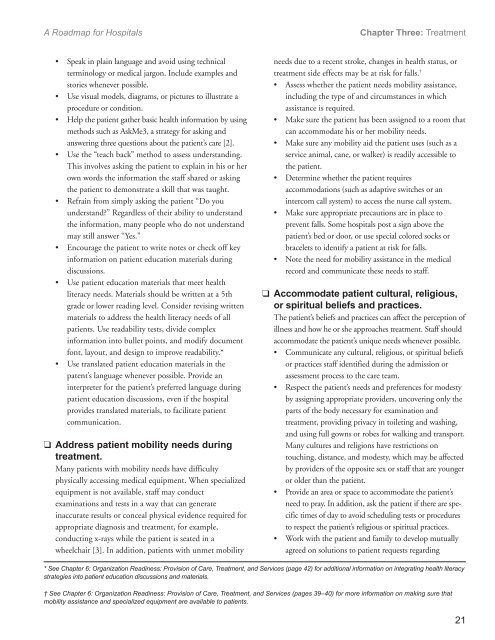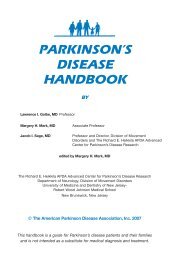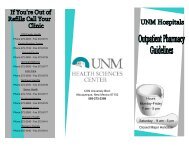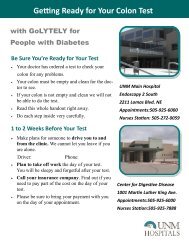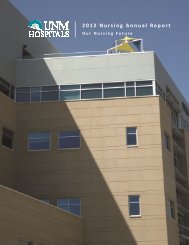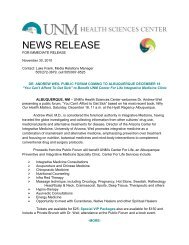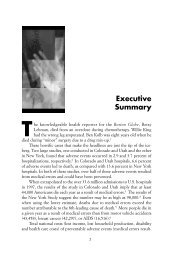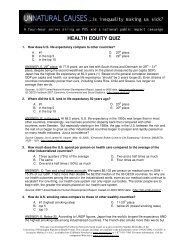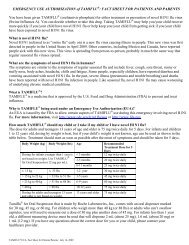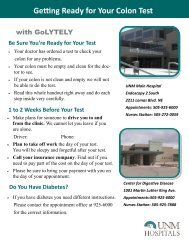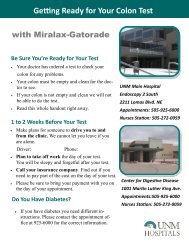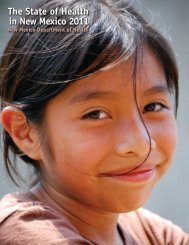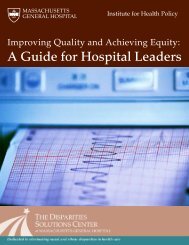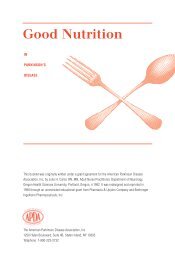Advanced Effective Communication, Cultural Competence, and ...
Advanced Effective Communication, Cultural Competence, and ...
Advanced Effective Communication, Cultural Competence, and ...
You also want an ePaper? Increase the reach of your titles
YUMPU automatically turns print PDFs into web optimized ePapers that Google loves.
A Roadmap for Hospitals<br />
Chapter Three: Treatment<br />
• Speak in plain language <strong>and</strong> avoid using technical<br />
terminology or medical jargon. Include examples <strong>and</strong><br />
stories whenever possible.<br />
• Use visual models, diagrams, or pictures to illustrate a<br />
procedure or condition.<br />
• Help the patient gather basic health information by using<br />
methods such as AskMe3, a strategy for asking <strong>and</strong><br />
answering three questions about the patient’s care [2].<br />
• Use the “teach back” method to assess underst<strong>and</strong>ing.<br />
This involves asking the patient to explain in his or her<br />
own words the information the staff shared or asking<br />
the patient to demonstrate a skill that was taught.<br />
• Refrain from simply asking the patient “Do you<br />
underst<strong>and</strong>?” Regardless of their ability to underst<strong>and</strong><br />
the information, many people who do not underst<strong>and</strong><br />
may still answer “Yes.”<br />
• Encourage the patient to write notes or check off key<br />
information on patient education materials during<br />
discussions.<br />
• Use patient education materials that meet health<br />
literacy needs. Materials should be written at a 5th<br />
grade or lower reading level. Consider revising written<br />
materials to address the health literacy needs of all<br />
patients. Use readability tests, divide complex<br />
information into bullet points, <strong>and</strong> modify document<br />
font, layout, <strong>and</strong> design to improve readability.*<br />
• Use translated patient education materials in the<br />
patent’s language whenever possible. Provide an<br />
interpreter for the patient’s preferred language during<br />
patient education discussions, even if the hospital<br />
provides translated materials, to facilitate patient<br />
communication.<br />
❑ Address patient mobility needs during<br />
treatment.<br />
Many patients with mobility needs have difficulty<br />
physically accessing medical equipment. When specialized<br />
equipment is not available, staff may conduct<br />
examinations <strong>and</strong> tests in a way that can generate<br />
inaccurate results or conceal physical evidence required for<br />
appropriate diagnosis <strong>and</strong> treatment, for example,<br />
conducting x-rays while the patient is seated in a<br />
wheelchair [3]. In addition, patients with unmet mobility<br />
needs due to a recent stroke, changes in health status, or<br />
treatment side effects may be at risk for falls. †<br />
• Assess whether the patient needs mobility assistance,<br />
including the type of <strong>and</strong> circumstances in which<br />
assistance is required.<br />
• Make sure the patient has been assigned to a room that<br />
can accommodate his or her mobility needs.<br />
• Make sure any mobility aid the patient uses (such as a<br />
service animal, cane, or walker) is readily accessible to<br />
the patient.<br />
• Determine whether the patient requires<br />
accommodations (such as adaptive switches or an<br />
intercom call system) to access the nurse call system.<br />
• Make sure appropriate precautions are in place to<br />
prevent falls. Some hospitals post a sign above the<br />
patient’s bed or door, or use special colored socks or<br />
bracelets to identify a patient at risk for falls.<br />
• Note the need for mobility assistance in the medical<br />
record <strong>and</strong> communicate these needs to staff.<br />
❑ Accommodate patient cultural, religious,<br />
or spiritual beliefs <strong>and</strong> practices.<br />
The patient’s beliefs <strong>and</strong> practices can affect the perception of<br />
illness <strong>and</strong> how he or she approaches treatment. Staff should<br />
accommodate the patient’s unique needs whenever possible.<br />
• Communicate any cultural, religious, or spiritual beliefs<br />
or practices staff identified during the admission or<br />
assessment process to the care team.<br />
• Respect the patient’s needs <strong>and</strong> preferences for modesty<br />
by assigning appropriate providers, uncovering only the<br />
parts of the body necessary for examination <strong>and</strong><br />
treatment, providing privacy in toileting <strong>and</strong> washing,<br />
<strong>and</strong> using full gowns or robes for walking <strong>and</strong> transport.<br />
Many cultures <strong>and</strong> religions have restrictions on<br />
touching, distance, <strong>and</strong> modesty, which may be affected<br />
by providers of the opposite sex or staff that are younger<br />
or older than the patient.<br />
• Provide an area or space to accommodate the patient’s<br />
need to pray. In addition, ask the patient if there are specific<br />
times of day to avoid scheduling tests or procedures<br />
to respect the patient’s religious or spiritual practices.<br />
• Work with the patient <strong>and</strong> family to develop mutually<br />
agreed on solutions to patient requests regarding<br />
* See Chapter 6: Organization Readiness: Provision of Care, Treatment, <strong>and</strong> Services (page 42) for additional information on integrating health literacy<br />
strategies into patient education discussions <strong>and</strong> materials.<br />
† See Chapter 6: Organization Readiness: Provision of Care, Treatment, <strong>and</strong> Services (pages 39–40) for more information on making sure that<br />
mobility assistance <strong>and</strong> specialized equipment are available to patients.<br />
21


